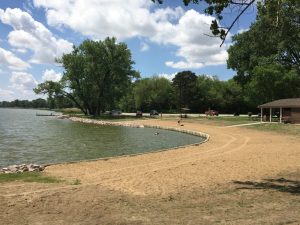DNR to host informational meeting about low levels in Blue Lake
June 25th, 2025 by Ric Hanson
(Onawa, Iowa; Iowa Capital Dispatch) – Years of drought conditions on Iowa’s western edge have lowered water levels at Blue Lake near Onawa, and impacted recreation at the lake. The Iowa Department of Natural Resources is hosting a public meeting Thursday in Onawa to discuss the low water levels and the department’s ongoing studies and lake restoration projects at Blue Lake. 200 years ago, when the Lewis and Clark expedition came through the region, the oxbow lake was an active channel of the Missouri River, but now it is fed by a small watershed off of the Missouri River, and is located in Lewis and Clark State Park just west of Onawa.
According to DNR’s annual lake restoration report, Blue Lake has a number of “aesthetically objectionable conditions” like algal blooms, and low water clarity that contributed to decreased recreational use. Since the early 2000s DNR has been working to restore the lake via chemical restoration, removal of “rough” fish and selective dredging. Water levels in the Missouri River have been “especially low” over the past five winters, which led to low groundwater levels in the region and impacted not only Blue Lake levels, but water in communities throughout western Iowa. The lake is currently about five feet below its crest elevation, or the fullest pool of the lake. Ben Wallace, a fisheries biologist who has worked on Blue Lake’s restoration projects said drop means the lake has about one third of its full-pool volume.
Wallace said the informational meeting Thursday will help address concerns within the community about the low lake levels and to explain DNR’s work at Blue Lake. According to the DNR report, the Lake Restoration Program spent about $10,000 on a dredging and fish barrier project at Blue Lake in the 2023-2024 fiscal year and allocated $265,000 in fiscal year 2025 for well and pump assessment, fish renovation and containment site improvements at the lake. Wallace said some folks in the community have questioned if the DNR’s dredging work contributed to the lake’s low levels, but he said lake restoration work is done very “systematically” with the “entire picture” in mind. Plus, Wallace said this isn’t the first time Blue Lake has had levels this low. He said historic maps of the region show levels just as low, if not lower in the 1930s. He said water levels in the lake are about on par with groundwater levels in the region. That type of drought takes more than just a good rain to replenish.

A beach area at Blue Lake in Lewis and Clark State Park. (Photo courtesy of Iowa DNR)
Restoration work at the lake has also addressed turbidity, or water clarity, by eliminating and blocking common carp from the lake. Wallace said these bottom-feeding fish continually stir up the sediment on the bottom of the lake which causes cloudy water, poor conditions for other fish and makes it easier for algae to bloom on the surface. Wallace said common carp are a problem at a lot of lakes in Iowa, but high densities in Blue Lake have impacted the water quality. DNR’s lake restoration efforts included the installation of fish barriers and aggressive carp angling in the lake to help reduce the common carp populations. In addition to the work to restore the lake, Lewis and Clark State Park Manager Nathan Fylstra said his team has been working hard to improve the state park with updates to the visitor’s center, improved drainage systems and a general clean up of ditches and fences.
The park is adjacent to the 250-acre Blue Lake, which typically hosts summer swimmers, boaters and anglers. Wallace encouraged anyone with an interest in Blue Lake to attend the informational meeting Thursday at the Onawa Community Center, 320 10th Street, at 5:30 p.m.





